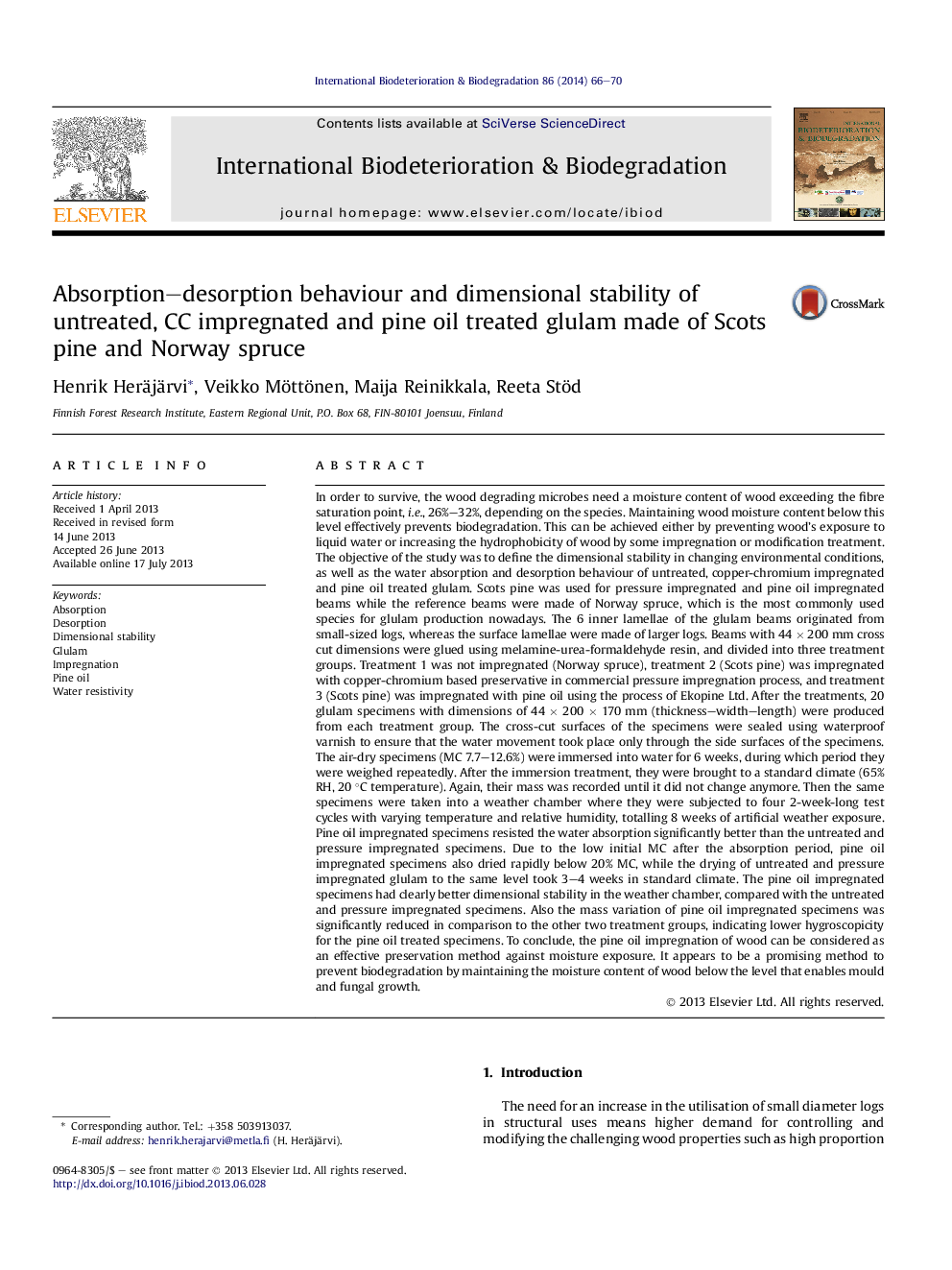| کد مقاله | کد نشریه | سال انتشار | مقاله انگلیسی | نسخه تمام متن |
|---|---|---|---|---|
| 4364853 | 1301727 | 2014 | 5 صفحه PDF | دانلود رایگان |
• We studied the dimensional stability and absorption–desorption behaviour of glulam.
• We compared non treated, pressure impregnated and pine oil treated glulam specimens.
• Pine oil treated specimens had the lowest MC after 6 weeks of immersion in water.
• Pine oil treated specimens had the best dimensional stability during weathering test.
• Pine oil treatment is an effective preservation method against moisture exposure.
In order to survive, the wood degrading microbes need a moisture content of wood exceeding the fibre saturation point, i.e., 26%–32%, depending on the species. Maintaining wood moisture content below this level effectively prevents biodegradation. This can be achieved either by preventing wood's exposure to liquid water or increasing the hydrophobicity of wood by some impregnation or modification treatment. The objective of the study was to define the dimensional stability in changing environmental conditions, as well as the water absorption and desorption behaviour of untreated, copper-chromium impregnated and pine oil treated glulam. Scots pine was used for pressure impregnated and pine oil impregnated beams while the reference beams were made of Norway spruce, which is the most commonly used species for glulam production nowadays. The 6 inner lamellae of the glulam beams originated from small-sized logs, whereas the surface lamellae were made of larger logs. Beams with 44 × 200 mm cross cut dimensions were glued using melamine-urea-formaldehyde resin, and divided into three treatment groups. Treatment 1 was not impregnated (Norway spruce), treatment 2 (Scots pine) was impregnated with copper-chromium based preservative in commercial pressure impregnation process, and treatment 3 (Scots pine) was impregnated with pine oil using the process of Ekopine Ltd. After the treatments, 20 glulam specimens with dimensions of 44 × 200 × 170 mm (thickness–width–length) were produced from each treatment group. The cross-cut surfaces of the specimens were sealed using waterproof varnish to ensure that the water movement took place only through the side surfaces of the specimens. The air-dry specimens (MC 7.7–12.6%) were immersed into water for 6 weeks, during which period they were weighed repeatedly. After the immersion treatment, they were brought to a standard climate (65% RH, 20 °C temperature). Again, their mass was recorded until it did not change anymore. Then the same specimens were taken into a weather chamber where they were subjected to four 2-week-long test cycles with varying temperature and relative humidity, totalling 8 weeks of artificial weather exposure. Pine oil impregnated specimens resisted the water absorption significantly better than the untreated and pressure impregnated specimens. Due to the low initial MC after the absorption period, pine oil impregnated specimens also dried rapidly below 20% MC, while the drying of untreated and pressure impregnated glulam to the same level took 3–4 weeks in standard climate. The pine oil impregnated specimens had clearly better dimensional stability in the weather chamber, compared with the untreated and pressure impregnated specimens. Also the mass variation of pine oil impregnated specimens was significantly reduced in comparison to the other two treatment groups, indicating lower hygroscopicity for the pine oil treated specimens. To conclude, the pine oil impregnation of wood can be considered as an effective preservation method against moisture exposure. It appears to be a promising method to prevent biodegradation by maintaining the moisture content of wood below the level that enables mould and fungal growth.
Journal: International Biodeterioration & Biodegradation - Volume 86, Part B, January 2014, Pages 66–70
